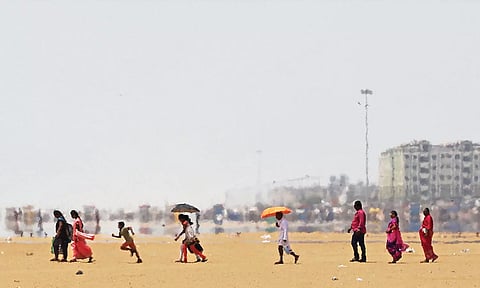

CHENNAI: If you are wondering why it feels hotter than what it should feel like while looking at the current temperature displayed on your phone's home screen, it's time to understand how temperature and humidity work in tandem and in opposition with each other.
In the last one week when Chennai and other parts of Tamil Nadu, and the country have been experiencing a substantial surge in temperature, the conversations online and in-person conversations about the weather were often about the actual temperature and “feels like” temperature. After all, 37-38 degrees Celsius does not capture the full extent of the oppressive weather that we feel unlike the “feels like” 54 degrees Celsius.
The factor that makes all the difference is humidity. And what increases humidity in Chennai is the sea breeze, the same winds that help keep the temperature from shooting up to mid-40s like in the case of interior areas like Erode or Karur in Tamil Nadu, or several parts in central India.
Explaining this, popular weather blogger K Srikanth says the air temperature is typically 36 or 37 degrees Celsius in Chennai. But when the sea breeze comes in during the afternoons, the humidity level spikes to 60-65 per cent. “Then, the temperature that the human body 'feels' is almost 44-45 degrees rather than the air temperature. That is why we feel that it is hotter in Chennai even though the actual air temperature here won't be as bad as the interior regions."
To put it simply, the temperature the body feels (also called ‘feels-like temperature’) when humidity is combined with the heat is called heat index, also known as apparent temperature. Hence, to describe how hot it feels, heat index is a better option than just the air temperature. For instance, Google showed Chennai at 38 degrees Celsius at 1 pm on May 2 but said the humidity levels made it feel like it was 54°C.
"If you look at the interior parts of Tamil Nadu, the humidity is much lower, as they don't have the effects of a sea breeze. Over there, the difference between the air temperature and the 'feels-like temperature' may not be felt as strongly as it is in Chennai. For example, in Erode, the temperature is typically 42-43 degrees Celsius, and the humidity is around 20 per cent. Thus, the 'feels-like' temperature there would be similar to the actual air temperature."
But it is not the same with Chennai or even Kolkata as they are coastal, he says. "In late May, the Westerlies blow into Chennai, and the temperature becomes higher, at 40-41 degrees Celsius. When the sea breeze arrives at 2 or 3 pm, it will be a weak one. So, the temperature won't cool down drastically, but the humidity levels will rise due to the moisture from the sea breeze. That time, you can also see the ‘feels like’ temperature going as far as 54-55 degrees," elaborates Srikanth.
However, there are contrasts between Chennai and the suburbs, he observes. One example he noted in the recent days was how the temperature was different in Tirunindravur, a suburb in the west of Chennai city, and Anna Nagar, which is closer to the coast. On May 1, Tirunindravur recorded a temperature of 42.9 degrees Celsius, while Anna Nagar only recorded a maximum of 39.6 degrees Celsius. The reason, he says, is because the sea breeze on that day was not strong enough to penetrate the city areas and move towards Tirunindravur, which is about 25-30 km from the coastline.
“We could see a dry weather pattern prevailing even in areas as close as Tirunindravur as compared to the hot and humid city areas."
In effect, the temperature in Anna Nagar is lesser than that in Tirunindravur, but the people in both these areas experience similar 'feels-like temperatures'. This is because "the higher humidity compensates for the lesser temperatures in the city areas", Srikanth says.
Observing how the public reacts differently to alerts being issued for different temperatures, he says, "When temperatures rise to 45 or 46 degrees Celsius and we get an alert, we react proactively, and we don't step out because we are used to absolute temperatures. However, when it is 36 or 37 degrees Celsius but coupled with high humidity, we don't always take it as seriously though the risk of getting a heatstroke is still there."
At lower temperatures, the risk may not be high. But if it is around 40 degrees Celsius and the humidity is high near the coast, then there is a higher risk of heatstroke, he warns.